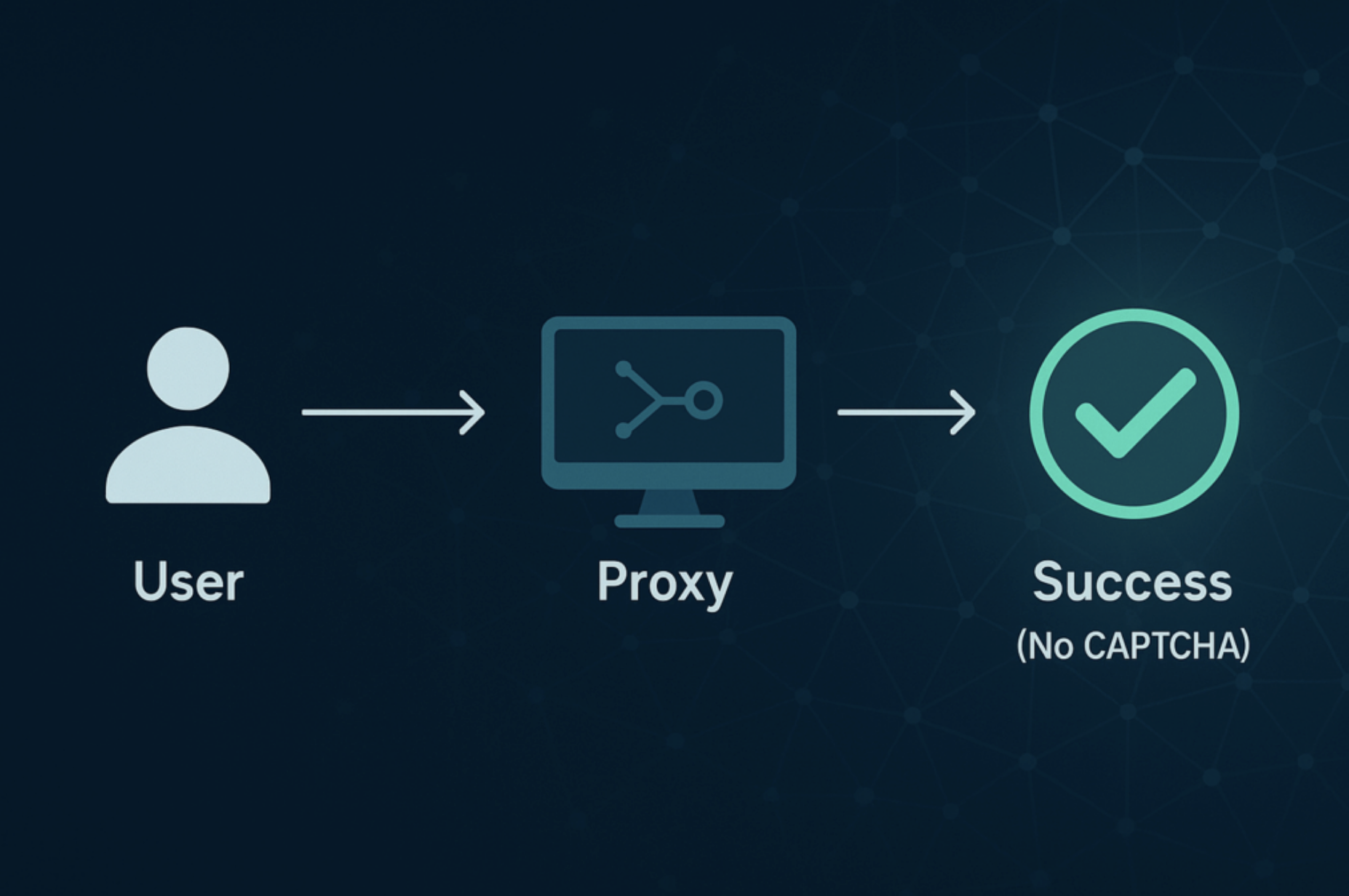
You’ve been there before. You launch your scraper, your automation workflow, or a simple account manager—everything runs smoothly for a few minutes… until the wall hits.
- “Please verify you’re human.”
- “Access temporarily restricted.”
- “Suspicious activity detected from your IP.”
It doesn’t matter whether you’re collecting data for SEO, monitoring e-commerce listings, or testing ad visibility—your project stalls, your session resets, and suddenly, you’re spending more time solving CAPTCHAs than doing actual work.
For years, the quick fix was obvious: “Just use a VPN or a datacenter proxy.” But as anti-bot systems have grown smarter, these tools have become the digital equivalent of using a loudspeaker in a library. They work, but everyone knows you’re not supposed to be there.
Today, teams that rely on automation, scraping, or large-scale research are shifting to a more adaptive, stealth-friendly solution—residential proxies.
So why do bans and CAPTCHA loops keep happening and how can residential proxies stop them for good? Let’s break it down.
Why IP Bans and CAPTCHA Loops Happen
If you’ve ever wondered why some websites suddenly decide you’re a “bot,” even when you’re just collecting data or logging in normally, the answer lies in how your connection looks, not what you’re actually doing.
Most modern websites and APIs are protected by automated detection systems such as Cloudflare, Akamai, PerimeterX, Google reCAPTCHA, and others. Their job is to identify unusual traffic patterns and stop them before they overload the servers or compromise data.
Here’s what typically triggers those systems:
- Too Many Requests from One IP: Datacenter proxies and VPNs often send hundreds of requests through the same address, a red flag for most filters.
- Non-Human Behavior: Repeated logins, identical headers, or robotic mouse movements make algorithms assume it’s a script, not a person.
- Suspicious Origin: When traffic comes from known hosting providers (AWS, DigitalOcean, Hetzner), sites instantly recognize it’s not a “real user.”
- Speed and Repetition: Scraping or automation tools can hit endpoints faster than any human ever could—which, ironically, is too efficient for their own good.
The result? You’re met with endless CAPTCHAs, login freezes, or full IP bans even if your intent is completely legitimate, like testing, price monitoring, or data research.
Mini insight: It’s not about what you do; it’s about how your connection appears to the target site.

Datacenter vs. Residential: What’s the Real Difference?
At first glance, all proxies might look the same. They mask your IP, reroute traffic, and give you some level of anonymity. But under the hood, there’s a world of difference between datacenter and residential proxies and that difference decides whether your connection survives the next CAPTCHA loop or not.
| Criterion | Datacenter Proxies | Residential Proxies |
|---|---|---|
| IP Source | Hosting providers or virtual servers (AWS, Google Cloud, Hetzner) | Real user devices connected through genuine ISPs |
| Detection Risk | Easily identified and flagged by websites as “non-human” | Appear organic, traffic looks identical to normal user activity |
| Speed and Stability | Typically faster, but prone to throttling or full bans under load | Slightly slower, but consistently stable under high-volume operations |
| CAPTCHA Frequency | High, frequent re-verification and session resets | Low, human-like patterns drastically reduce detection triggers |
| Best Use Cases | Testing environments, non-critical automation | Large-scale scraping, analytics, SEO, AI data pipelines, and sensitive workflows |
In short, datacenter proxies are like sprinting through a hallway full of motion sensors—fast, but you’ll get stopped sooner or later. Residential proxies, on the other hand, move naturally, blending into everyday network traffic.
Takeaway: Speed doesn’t matter if you’re constantly blocked. Stability wins every time.
Practical Use Cases: Where Residential Proxies Save Time (and Sanity)
The real difference between datacenter and residential proxies isn’t visible in the setup; it’s visible in the results. Here’s where switching to residential IPs instantly removes friction and wasted hours.
1. Web Scraping and Data Mining
Whether you’re collecting search engine results, price listings, or product reviews, most websites now limit or block requests that look automated. Residential proxies distribute traffic across real user IPs, letting scrapers pull structured data at scale without IP bans, throttling, or endless CAPTCHA prompts.
2. SEO and Market Intelligence
Analyzing regional SERPs or tracking competitor visibility requires local accuracy. With residential proxies, analysts can simulate genuine searches from specific cities, regions, or ISPs—getting clean, unbiased results for every target market.
3. Ad Verification
Brands and agencies rely on residential proxies to verify that their ads display correctly across multiple regions, devices, and platforms. They ensure ad campaigns are visible where intended and not hijacked, blocked, or spoofed by intermediaries.
4. Automation and Social Media Management
Managing multiple social media or business accounts from one location can trigger auto-bans. Residential IPs create natural separation between sessions, mimicking authentic logins from different users—no flags, no verifications, no downtime.
5. AI Training and Dataset Collection
AI models need diverse, region-specific datasets—text, images, and video—to perform accurately. Residential proxies enable continuous, large-scale data access across countries and domains, making model training both ethical and efficient.
Bottom Line: The best automation workflows aren’t the fastest. They’re the ones that never get interrupted.
Why Scalable Proxy Infrastructure Matters
Modern proxy systems are no longer just about masking IPs. They’re about maintaining scale, reliability, and compliance for demanding workflows like AI research, automation, and enterprise data operations.
An effective proxy network typically includes:
- Global Reach: A large, distributed pool of residential IPs across multiple regions to ensure diverse, reliable connectivity.
- Performance Optimization: Intelligent routing that minimizes latency, maintains consistent bandwidth, and prioritizes stable IPs based on connection history.
- Tool Compatibility: Seamless integration with development environments such as Python, Node.js, R, Postman, and Selenium to support both lightweight scripts and enterprise-scale applications.
- Compliance Standards: Adherence to frameworks like ISO/IEC 27001:2017 and GDPR ensures that proxy operations align with global standards for data privacy and security.
In essence, scalability in proxy infrastructure isn’t about speed alone — it’s about maintaining uninterrupted, ethical, and secure access for data-driven workflows.
Staying Ethical: The Responsible Way to Use Proxies
Power always comes with responsibility and proxy technology is no exception. As proxies become a standard part of data-driven workflows, ethical and compliant use is what separates sustainable innovation from risky automation.
Here’s what responsible proxy usage looks like in 2025 and beyond:
- Use proxies for legitimate purposes: Data collection, performance testing, SEO monitoring, ad verification, or AI model training, not intrusion or spam.
- Respect privacy and platform rules: Even if a proxy helps you bypass limits, stay within the legal frameworks of GDPR, CCPA, and each platform’s terms of service.
- Choose transparent providers: Trust matters. Work with companies that clearly disclose how they source IPs, manage logs, and ensure user consent. For example, providers such as Gonzo Proxy demonstrate this transparency by maintaining ISO-certified infrastructure that aligns with recognized global standards.
Because smart proxy usage isn’t about hiding; it’s about optimizing.
Smart use of proxies isn’t about avoiding rules; it’s about working within them efficiently.
Final Takeaway: Smarter, Safer, Smoother Access
IP bans and CAPTCHA loops aren’t a “cost of doing business." They’re a symptom of outdated infrastructure. Modern operations need proxy systems that are adaptive, ethical, and built for scale.
Residential proxies have become the invisible foundation of reliable automation, AI research, and global analytics, ensuring data flows without friction and security stays uncompromised.
In a world full of firewalls, the smartest path is the one that never gets flagged.
Disclaimer
The information provided in this article is for educational and informational purposes only. It does not constitute legal, ethical, or professional advice. The use of proxy services should always comply with applicable laws, website terms of service, and privacy regulations such as GDPR and CCPA. References to third-party services are for illustrative purposes only and do not imply endorsement or affiliation. iplocation.net is not responsible for any misuse of proxy technologies or external links mentioned in this content.



Comments (0)
No comment